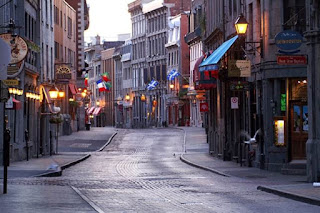 Happy 4th of July America.!
Happy 4th of July America.!We're spending the day in Old Montreal, Quebec which dates back to New France.
Wonderful architecture, including preserved colonial mansions such as the Chateau Ramezay, cobble-stoned streets and horse-drawn carriages add to the area's charm and elegance. The old town's riverbank, taken up by the Old Port, is surrounded by a variety of museums and attractions.
The oldest area of Montreal is known, not surprisingly, as Old Montreal or Vieux-Montreal in French. This historic center was once walled and still boasts delightful cobbled stones from the 17th – 19th centuries and the Old Montreal Port on the banks of the Saint Lawrence River. In 1964, the government of Quebec declared Old Montreal a historic district and in recent years, the district has been expanded slightly to incorporate several other streets. The area is considered a major tourist attraction and includes many of Montreal’s most visited institutions, including the Bonsecours Market, the Notre-Dame-de-Bon-Secours Chapel, Montreal City Hall, the Chateau Ramezay, the Notre-Dame Basilica, the Saint-Sulpice Seminary and Canada’s oldest skyscraper, the New York Life Building, dating back to 1888. Old Montreal actually has one of the largest concentrations of historical homes and museums.
Place de Arms
Place d'Armes, the veritable heart of the city, offers a striking historical panorama. Here all the periods of Montréal's past are gathered in one place, around a monument dedicated to the city's founders. This section features the oldest standing building in Montréal, the huge church of the city's mother parish, the head office of the country's oldest bank, the city's first skyscraper... and the generations of skyscrapers that followed.
The New York Life building, with its eight stories served by an elevator and its clock tower, was Montréal's first skyscraper.
Basilique Notre Dame de Montreal
 The beautiful Gothic Revival style church built in 1829 and completed over decades is our first stop. The interior of the church is highly decorated. Its vaults are colored deep blue with golden stars and the rest of the sanctuary is decorated in blues, azures, reds, purple, silver and gold. There are hundreds of intricate wooden carvings and statues. The stained glass depicts the city's religious history. Pope John Paul II declared the church a minor basilica during his visit in 1982.
The beautiful Gothic Revival style church built in 1829 and completed over decades is our first stop. The interior of the church is highly decorated. Its vaults are colored deep blue with golden stars and the rest of the sanctuary is decorated in blues, azures, reds, purple, silver and gold. There are hundreds of intricate wooden carvings and statues. The stained glass depicts the city's religious history. Pope John Paul II declared the church a minor basilica during his visit in 1982. Pointe-à-Callière Museum
Pointe-à-Callière MuseumPointe-à-Callière Museum is a museum of archaeology and history in Old Montreal. It was founded in 1992 as part of celebrations to mark Montreal's 350th birthday. The museum has collections of artifacts from the First Nations of the Montreal region that illustrate how various cultures coexisted and interacted, and how the French and British regimes influenced the history of this territory over the years.
A special exhibit on the Queens of Egypt will be there while we visit.
Hotel de Ville

Montréal City Hall or Hotel de Ville has a more turbulent history than its peaceful façade suggests. The building went up between 1872 and 1878, and survived a severe fire in 1922. And it was from this balcony that French President General de Gaulle uttered his famous "Vive le Québec libre!" during a state visit in 1967. The architecture is Second Empire like Philadelphia's city hall.
Bonsecours Market
 The Bonsecours Market, a jewel in Montréal's heritage crown, was inaugurated in 1847. A symbol of Montréal's heyday, this imposing building was the city's main agricultural marketplace for over a century. It also housed a concert hall and even served as a city hall in the early days of Montréal.
The Bonsecours Market, a jewel in Montréal's heritage crown, was inaugurated in 1847. A symbol of Montréal's heyday, this imposing building was the city's main agricultural marketplace for over a century. It also housed a concert hall and even served as a city hall in the early days of Montréal.  Vieux-Port de Montreal, or the Old Port of Montreal, was officially opened in 1830, although it was used as early as 1611 as a trading post among French fur traders who ventured into the region. Today, the Old Port of Montreal, which stretches 2km along the shores of the St. Lawrence River, is a prime entertainment destination.
Vieux-Port de Montreal, or the Old Port of Montreal, was officially opened in 1830, although it was used as early as 1611 as a trading post among French fur traders who ventured into the region. Today, the Old Port of Montreal, which stretches 2km along the shores of the St. Lawrence River, is a prime entertainment destination.
The historic port was in operation until the 1970s, before the government decided to move the city’s port activities to its current location at Mercier-Hochelaga-Maisonneuve. In the 1990s, the architects Aurele Cardinal and Peter Rose helped plan the redevelopment of the Old Port as a premier tourist and recreation center.


No comments:
Post a Comment